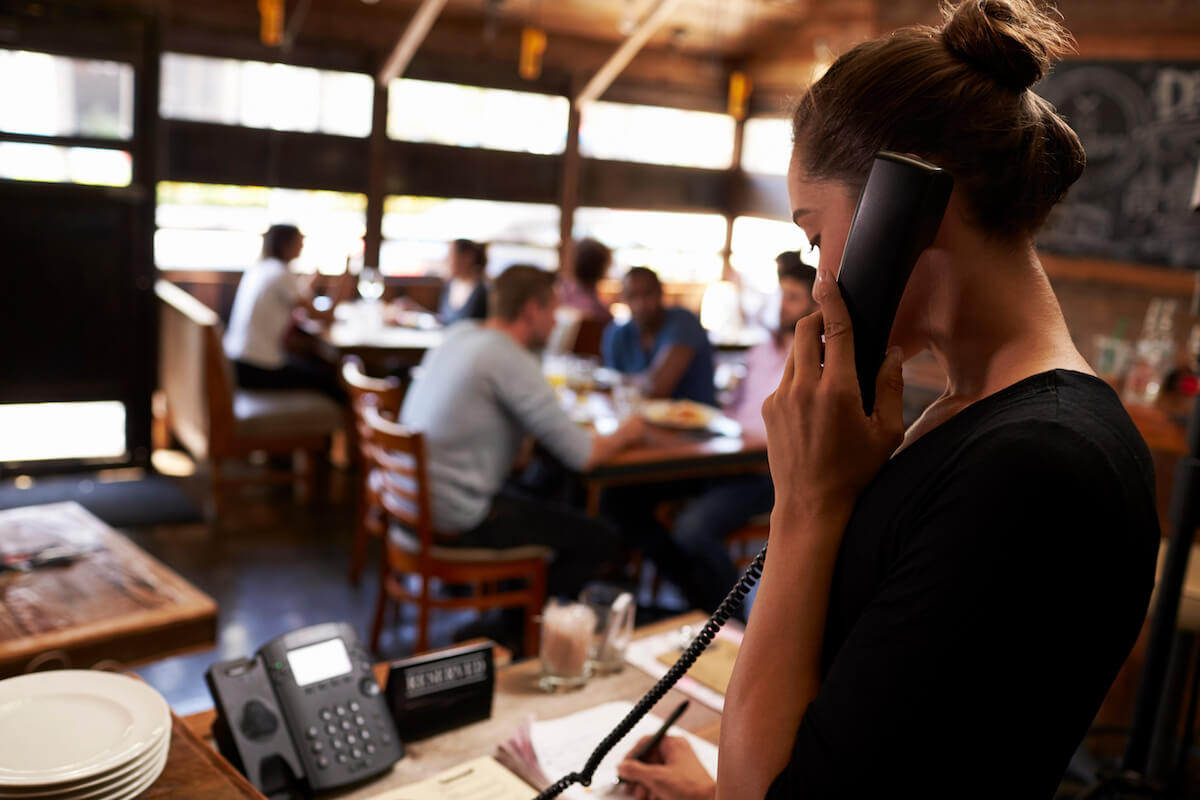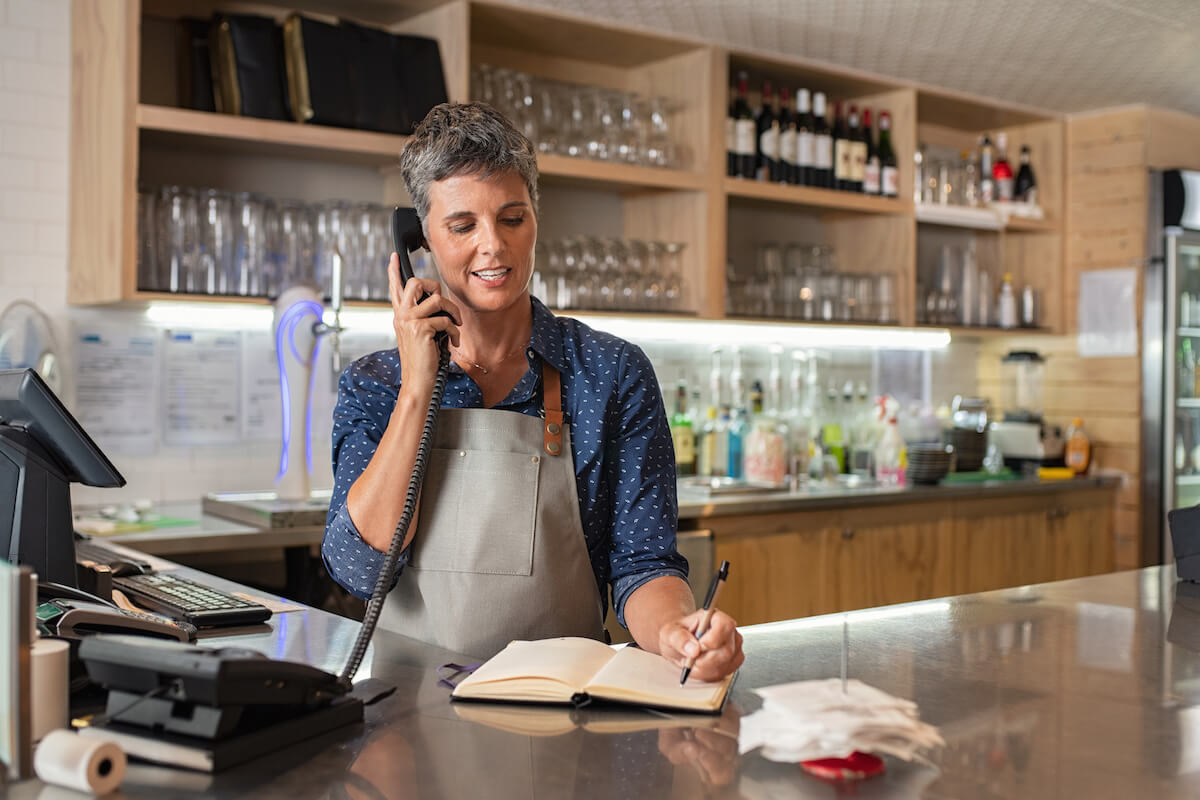- Telephone orders remain an important revenue source for restaurant operators, accounting for 28% of total ticket sales
- Digital phone systems are critical for maintaining strong phone sales, outperforming analog phones by sending more information at once with a lower error rate
- Equipping your store with digital phones is essential for modernizing your restaurant, as necessary technology platforms require digital phones to operate.
The pandemic not only changed how quick-service restaurants operate but also shifted consumer habits toward takeout and delivery, rather than ordering at the store and eating on site. Today, remote ordering is the primary source of revenue for restaurants, with the average quick-service restaurant earning nearly 70% of sales from phone and digital orders.
Even with mobile delivery apps and other online ordering methods available, guests still overwhelmingly prefer to order by phone, and a 2021 survey found that phone orders account for 28% of annual revenue, demonstrating how phone systems remain a mainstay of restaurant operations today.
Quick-service restaurants (QSRs) have a variety of phone networks to choose from, like digital phone services, analog phone systems and specialized digital phone networks like voice over internet protocol (VoIP). Restaurants earn a significant amount oftheir sales from delivery apps and foot traffic, but in a business sector with such tight profit margins, QSR operators can’t afford to neglect any potential revenue source, especially a channel as impactful as phone orders.
Restaurants that choose to upgrade from analog to digital phone systems will gain opportunities to access a host of technology platforms that help operators modernize their stores, improve efficiencies and boost sales. For example, voice artificial intelligence (AI) technology provides restaurant owners with the ability to automate the ordering process with virtual ordering assistants, freeing up staff to become more productive as they are singularly focused on food prep, order fulfillment and in-person guest service. Voice AI helps restaurants not miss or rush phone orders, which would normally lead to lost revenue and dissatisfied diners. Without AI, if a potential guest’s phone call isn’t answered or they are put on hold, they likely aren’t going to leave a voicemail and won’t necessarily call again—instead, they might just order from a competitor. Being able to take advantage of technologies such as voice AI, however, is only possible if a restaurant uses upgraded digital telephone systems. Let’s dive into why upgrading to digital phone systems quickly pays off for restaurant owners and operators.
4 types of restaurant phone systems

In the past, analog phone networks were the only available telephone service option for businesses and the most common medium for guests to place their food orders remotely. In 2022, restaurant operators have more choices: they can freely pick between four main options for phone systems, with traditional analog networks giving way to a variety of digital phone systems.
Analog phone system
Restaurants traditionally have relied on classic analog phone systems, also referred to as plain old telephone service (POTS). Analog phones work ‘the old-fashioned way’ by converting speech into electrical waveforms and transmitting these waves across copper wires from one end of a phone line to another. One analog phone number is associated with one phone line, meaning that an analog phone can only hold one conversation at a time, and anyone else trying to get through will hear a busy signal.
Today, a restaurant may have a standard landline phone, have an older-generation fax machine in the office, and use a computer modem — all of those rely on traditional analog technology.
Digital phone system
Digital phones communicate over the internet, whether for local, long-distance, or international calling. Fixed digital phone systems such as corporate desk phones translate audio and video calls into digital signals, sending them down a line of fiber optic cables, whereas cell phones rely on radio signals instead of cable connections. Restaurant digital phone systems are built over existing analog systems and run across the same phone lines, but use upgraded equipment compatible with modern telecommunications technology. Think of digital phone systems as an enhancement that takes restaurants’ existing phones into the modern digital age, while still maintaining the familiar architecture phones have always run on.
VoIP phone system or IP telephony
Imagine getting rid of your landline completely. IP telephone systems (internet protocol) and VoIP, which stands for Voice over internet protocol, allow users to make and receive phone calls through the internet instead of over landlines. VoIP uses an existing internet connection that users typically get through telecom companies such as AT&T, Cisco, Avaya or Panasonic. Although VoIP is also a type of digital telephone, it technically differs from digital phone networks in the connection it uses to transmit data. Most digital phone systems rely on physical phone lines to send signals, while VoIP uses signal connections (i.e. internet services). Callers commonly wear a computer headset with an attached microphone or use a Bluetooth-capable cell phone. Either way, the VoIP network sends outgoing calls across the internet to the recipient. If a restaurant’s digital phone systems operate online instead of with physical phone lines, it’s using VoIP networks.
Many professionals refer to VoIP and IP phone systems interchangeably. Both IP phones and VoIP encompass communication carried out over an IP service, including voice communication, text messages, faxing and video conferencing.
Why digital outperforms analog phone systems

Digital phone networks consistently outperform analog phone systems in restaurant business operations. Here are some of the advantages of digital phone systems:
- Digital phones include all expected calling features like caller ID and call forwarding, while simultaneously providing better sound quality and fewer dropped calls
- Digital phones have greater bandwidth (the ability to send more information at once) and offer unlimited long distance calls and additional functionality
- When restaurant operators choose to modernize their restaurants with digital phone systems instead of analog phones, they gain the opportunity to add helpful technologies, such as voice AI, to their operations. Restaurant voice AI is a proven commodity, creating revenue growth and improving service standards by automating the ordering process with virtual ordering assistants
Analog phone systems are more affordable but offer no other real advantages to QSR operators. In fact, choosing between analog or digital phone systems is similar to picking either a flip phone or smartphone: yes, the flip phone costs much less upfront, but the smartphone ultimately has many additional features and a level of customizability that makes it a much better purchase over the long-term.
Being able to integrate advanced AI technology into a restaurant’s phone system is one of digital’s most compelling advantages over analog phones, and a big reason to upgrade. Voice AI systems are incompatible with analog phone networks, but let’s dive into why it would be worth upgrading to digital to start using voice AI.
Digital phone systems are essential for modernizing restaurants

Technology is shaping all industries today, especially the restaurant world, where restaurant technology platforms are abundant and available to help with all aspects of restaurant operations, from ordering to guest service and more. Platforms offer the ability to add contactless ordering and no-touch payment options, which guests expect in the wake of the pandemic. Additionally, high-tech automation such as artificial intelligence (AI) is available to reduce face-to-face contact and create operational efficiencies as well. In order to take advantage of the benefits these technology platforms offer, restaurant operators must modernize their restaurants to digital phone systems over traditional analog landlines which can’t fully integrate with all these new systems.
Using a digital phone system also opens doors for owners and operators to capture more restaurant data and have better reporting to guide business decisions. For example, POS reporting from a digital phone allows restaurant operators to track top-selling menu items, peak business hours and loyalty reward redemptions. These features guide restaurant management toward optimizing their menu options and scheduling the right number of team members according to the expected volume of guests.
Among the many modern restaurant technologies available, voice AI is one of the most game-changing, and it’s sweeping the quick-service restaurant industry, which continues to grapple with labor shortages and overworked staff caused by The Great Resignation. Voice AI-powered virtual assistants help restaurants automate their ordering process by responding to multiple calls at once, so guests never get busy signals, aren’t put on hold and get the personalized attention they deserve. Voice AI integrates with digital phone systems to help restaurants achieve up to 15% increased average tickets and up to 25% boosted gross margins due to voice AI’s ability to capture more orders and to automatically upsell guests.
Voice AI operates automatically, allowing restaurant leadership to reallocate staff to other tasks. Instead of juggling phone calls and taking down orders, team members can be more productive by focusing on prepping orders and servicing walk-in guests.
Upgrade your restaurant’s phone systems to take advantage of voice AI

Phone orders are as important as ever for restaurant operators to maintain healthy sales. Digital phone systems allow restaurants to take full advantage of the spectrum of restaurant technologies available, from contactless features to voice AI ordering platforms to other automation and advanced reporting systems, all of which can make running a restaurant more profitable and improve the experience for guests and staff.
Guests today also are increasingly expecting personalized service and customized food orders, making it more important than ever for restaurants to be able to provide guests with one-on-one attention. Voice AI is a powerful tool to satisfy these demands, as AI-powered virtual ordering assistants platforms to dynamically interact with guests, remembering past orders and providing guest-centric service and relevant menu recommendations, including custom upsells.
ConverseNow’s industry-leading voice AI virtual ordering assistants now operate in more than 1,100 stores across 40 U.S. states, including popular national and regional brands such as Domino’s, Fazoli’s and Blake’s Lotaburger. Modernize your restaurant phone networks to digital phone lines to make sure you can take advantage of the power of voice AI to automate your ordering process. Schedule a demo today with ConverseNow.